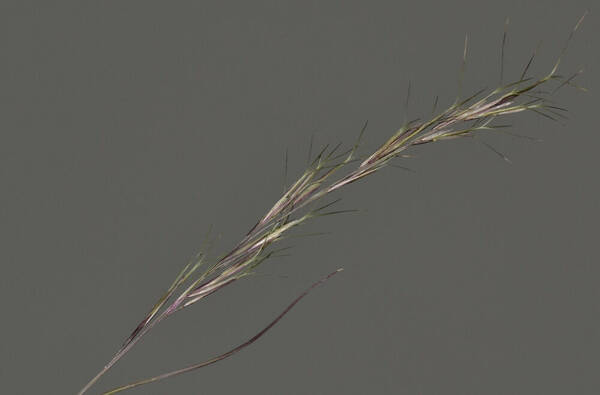Info
Subfamily: Aristidoideae
Genus etymology: Aristida was an ancient Latin name for an awned grass
Species etymology: adscensionis = from Ascension Island, although this grass is native across the tropics
Photosynthetic type: C4 (warm season)
Nativity: naturalized - accidental
First recorded in Hawaiʻi: 1903
Map

Inflorescence
 image credit: InatKbash
image credit: InatKbash image credit: InatKbash
image credit: InatKbashPlant
 image credit: InatKbash
image credit: InatKbashHabit

Description
Annual, forming erect or sprawling tufts 10–100 cm. high. Leaf-blades linear, up to 20 cm. long and 3 mm. wide, expanded or folded. Panicle up to 30 cm. long, occasionally lax, usually ± contracted about the main branches, sometimes narrow and dense. Spikelets pallid, green or tinged with purple; glumes unequal, linear-lanceolate to lanceolate, scaberulous on the keel, emarginate and mucronate or acute but never awned, the upper 5–10 mm. long, the lower 1–3 mm. shorter; lemma 5–13 mm. long, sometimes no longer than the glumes but usually exceeding the upper by 1–2 mm. or more, laterally compressed, convolute, scabrid on the keel or sometimes generally scaberulous on the upper part, passing into the awns without constriction or articulation; callus narrowly oblong, 0.5 mm. long, obtuse; central awn 7–25 mm. long, the laterals subequal or occasionally conspicuously shorter.
(Description source: Clayton, W.D. 1970. Flora of Tropical East Africa. Gramineae (Part 1). Crown Agents for Oversea Governments and Administrations, London. 176 pp. )
Annual or short-lived perennial up to 75 cm high (usually much less). Panicle usually contracted about the primary branches, these either spreading or appressed to the main axis (but the panicle never spike-like). Glumes unequal, linear-lanceolate, the lower 4–8.5 mm long, acute, the upper 7–11.5 mm long, obtuse or emarginate to apiculate; lemma, including the callus, (5–)11.5–17 mm long, laterally compressed, scabrid on the keel and sometimes also on the flanks, passing into the awns without either column or articulation; awns terete, the central (0.7–)1.5–2.5 cm long, the laterals similar or a little shorter.
(Description source: Cope, T.A, (1995) Flora Somalia, Vol 4. Royal Botanical Gardens, Kew, London. 312 pp. )
Annual, 10-100 cm. high, caespitose. Culms erect, somewhat geniculately ascending, often branched from the base and lower nodes, glabrous, smooth, often purplish; nodes glabrous, smooth. Leaf-sheaths tightly or laxly embracing the culm, more or less keeled, striate, smooth or scaberulous. Ligule a short-ciliate rim; auricles smooth or minutely pubescent; collar glabrous. Leaf-laminae up to 15 x 0·1-0·25 cm., linear, usually flat, scabrid above, usually glabrous beneath, with margins conspicuously thickened. Panicle up to 25 x 0·1-0·25 cm., exserted, erect, narrow and dense, interrupted at the base, or lax, many-flowered with a scabrous axis and appressed, erect or somewhat spreading, scabrous or scaberulous branches. Spikelets greenish or green tinged with purple. Glumes unequal, linear-lanceolate to lanceolate-oblong, more or less keeled; the inferior 4-7 mm. long, 1-nerved, minutely scaberulous or glabrous, emarginate at the apex with obtuse lobes and with an exserted mucro from the sinus, or acute, scabrous or scaberulous on the keel; the superior up to 6-8·5 mm. long, erose, 2-fid at the apex, with a mucro or short awn from the sinus, becoming scabrous on the keel towards the apex. Lemma (5·5)8-10(14) mm., usually exceeding, sometimes as long as, the glumes, tubular or slightly compressed, not narrowed upwards, pallid, usually with purple spots or tinged with purple, finely punctulate and scabrous on the keel, rarely scabrous on lateral sides towards the apex; column absent; awns unequal or subequal, more or less winged towards the base, very scabrous, the central awn being up to 20 mm. long, lateral ones 8-15 mm. long; callus 0·5-0·7 mm. long, obtuse, densely shortly barbate; articulation absent. 2n = 22.
(Description source: Launert, E. & Pope, G.V. (eds.). 1989. Flora Zambesiaca. Volume 10. Part 3. Kew, London. 152 pp )
Plants short- to long-lived annuals. Culms (3)10-50(80) cm, often highly branched above the base. Leaves cauline, glabrous; sheaths shorter than the internodes, not disintegrating into thread like fibers; ligules 0.4-1 mm; blades 2-14 cm long, 1-2.5 mm wide, flat to involute. Inflorescences panicles, 5-15(20) cm long, 0.5-3 cm wide, often interrupted below; nodes glabrous or with straight, less than 0.5 mm hairs; primary branches 1-4 cm, erect to ascending, without axillary pulvini, with 3-8 spikelets. Spikelets crowded. Glumes unequal, 1-veined, acuminate; lower glumes 4-8 mm; upper glumes 6-11 mm; calluses 0.5-0.8 mm; lemmas 6-9 mm, slightly keeled, midveins scabrous, junction with the awns not evident; awns not disarticulating at maturity, flattened and straight to somewhat curved at the base, central rib flanked by equally wide pale wings; central awns 7-15(20) mm; lateral awns somewhat shorter, occasionally only 1-2 mm; anthers 3, 0.3-0.7 mm. 2n = 22.
(Description source: Barkworth, M.E., Capels, K.M., Long, S. & Piep, M.B. (eds.) 2003. Flora of North America, north of Mexico. Volume 25. Magnoliophyta: Commelinidae (in part): Poaceae, Part 2. Oxford University Press, New York. 783 pp. http://floranorthamerica.org/Aristida_adscensionis )